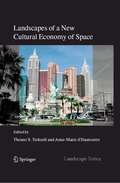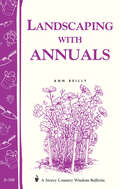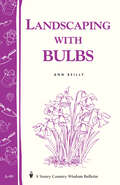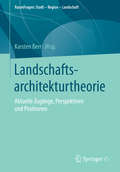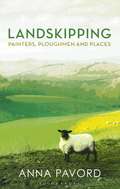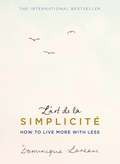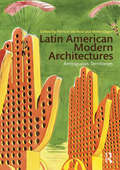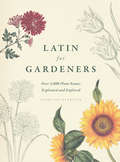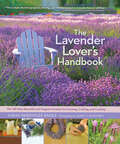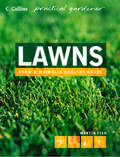- Table View
- List View
Landscape, Well-Being and Environment
by Richard Coles Zoë MillmanWell-being is now firmly established as an overarching theme of key concern to all professionals that work, manage or design the environment. However, well-being is a complex multi-dimensional issue rooted in the ways that we encounter, perceive and interpret the environment. No single discipline can claim to have sufficient knowledge to fully explain the types of interactions that occur, therefore there is a need to draw together a wide range of professions who are exploring the consequences of their actions upon the well-being of individuals and communities. This edited work addresses the above, consisting of a collection of studies which embrace different aspects of environment, landscape and well-being to consider current approaches to well-being research and practice that fall outside the traditional concepts of well-being as part of medical research, making links with architecture, landscape design, environmental perception, social interaction and environmental sustainability. The contributors originally presented at the international conference, ‘Well-Being 2011’ jointly hosted by Birmingham City University and the Royal Institute of British Architects (RIBA); the chapters have been developed to present a coherent series of themes reviewing a wide range of literature, presenting case studies appropriate to diverse audiences.
Landscapes of a New Cultural Economy of Space (Landscape Series #5)
by Theano S. Terkenli Anne-Marie D'HauteserreMaking sense of new cultural economies, it is argued, needs consistent attention to the resonances of individual lives. Otherwise, a discussion of cultural economies remains suspended in a detached virtualism (Miller, 2000). The idea of the remaking of geographies and cultural economies remains, necessarily, a consistent search to make the subject dynamic in its resonance with the contemporary world. In recent debates concerning the reframing of the cultural economies of geography, there is an evidence of increasing acknowledgement of the overlooked importance of subjectivities within geographical explanation. This has often been difficult when trying to attend to the large scale apparent dynamics of change. The shift of geographies to focus upon cultural economies combines two profound threads that inform this chapter: the acknowledgement of the breadth and inclusivity of what economies are and the refusal mutually to isolate the cultural and the economic. Thus the economic becomes engaged and even framed in relation to the cultural, and vice versa. Such an appraisal makes more robust the limits of ‘either – or’ claims from these two grounding components of geographical thinking and its representation of the world. These themes are sustained in different ways across the chapters of this book. This chapter seeks to build a critical discourse concerning space, embodied practice and lay knowledge. It does this in order to address the mechanisms through which individuals are engaged in the processes of new cultural economies.
Landscapes of Housing: Design and Planning in the History of Environmental Thought
by Jeanne HaffnerIn the twenty-first century, housing has become a site of ecological experimentation and environmental remediation. From the vantage point of contemporary architecture, conservation concerns and emergent building science technologies support one another, with new processes and materials deployed to reduce energy usage, water consumption, and carbon dioxide emissions. Landscapes of Housing examines this trend in historical perspective, arguing for a more considered environmental vision that includes the organic, social, and cultural dimensions of landscape. By shifting the focus from architecture, the book highlights and critiques the relationship between dwelling and landscape itself. Contributors from a wide range of international perspectives propose a more integrative ecology that includes history, culture, society, and materiality, in addition to technology, within contemporary ecological housing programs. This book will be a resource for upper-level students, academics, and researchers in landscape architecture interested in the social and political implications of ecological housing.
Landscapes of Housing: Design and Planning in the History of Environmental Thought
by Jeanne HaffnerIn the twenty-first century, housing has become a site of ecological experimentation and environmental remediation. From the vantage point of contemporary architecture, conservation concerns and emergent building science technologies support one another, with new processes and materials deployed to reduce energy usage, water consumption, and carbon dioxide emissions. Landscapes of Housing examines this trend in historical perspective, arguing for a more considered environmental vision that includes the organic, social, and cultural dimensions of landscape. By shifting the focus from architecture, the book highlights and critiques the relationship between dwelling and landscape itself. Contributors from a wide range of international perspectives propose a more integrative ecology that includes history, culture, society, and materiality, in addition to technology, within contemporary ecological housing programs. This book will be a resource for upper-level students, academics, and researchers in landscape architecture interested in the social and political implications of ecological housing.
Landscapes of Leisure: Space, Place and Identities (Leisure Studies in a Global Era)
by Sean Gammon Sam ElkingtonThis volume aims to map out the complex relationships leisure has with notions of place and space in contemporary life. Illustrating the transdisciplinarity of this key feature of leisure studies, it explores how leisure places and spaces affect personal, social and collective identities.
Landscaping Basics For Dummies, Mini Edition
by Philip Giroux National Gardening AssociationNo synopsis available.
Landscaping For Dummies
by Teri Dunn Chace National Gardening Association Philip Giroux Bob Beckstrom Lance WalheimCreate an eye-catching outdoor oasis with this no-nonsense guide to landscaping As families spend more time at home, they're expanding their living space to their yards, decks, and patios. When you're ready to upgrade the look of your landscape, Landscaping For Dummies offers advice on installing fences and walkways, choosing hardy plants and trees, and enhancing natural habitats for the critters and creatures lurking in your neighborhood. You'll find out how to make your backyard a relaxing retreat space and discover the enjoyment and satisfaction that comes from working in your yard. Landscaping For Dummies includes: Lists of recommended plants and varieties, including the best ones for privacy plantings, low-maintenance groundcovers, and small gardens Advice on how to deal with special landscaping concerns, including fire-prone areas, bee and butterfly gardens, and drought-tolerant and native landscapes Instructions on installing permanent features like decks, patios, fences, and more Pointers on how to water more efficiently, including the latest tools and technologies that can save you time With a little bit of planning and some digging, trimming, or planting, you'll be set to enjoy your yard whenever the mood strikes. Let Landscaping For Dummies be your guide to making the most of your outdoor space.
Landscaping For Dummies
by Teri Dunn Chace National Gardening Association Philip Giroux Bob Beckstrom Lance WalheimCreate an eye-catching outdoor oasis with this no-nonsense guide to landscaping As families spend more time at home, they're expanding their living space to their yards, decks, and patios. When you're ready to upgrade the look of your landscape, Landscaping For Dummies offers advice on installing fences and walkways, choosing hardy plants and trees, and enhancing natural habitats for the critters and creatures lurking in your neighborhood. You'll find out how to make your backyard a relaxing retreat space and discover the enjoyment and satisfaction that comes from working in your yard. Landscaping For Dummies includes: Lists of recommended plants and varieties, including the best ones for privacy plantings, low-maintenance groundcovers, and small gardens Advice on how to deal with special landscaping concerns, including fire-prone areas, bee and butterfly gardens, and drought-tolerant and native landscapes Instructions on installing permanent features like decks, patios, fences, and more Pointers on how to water more efficiently, including the latest tools and technologies that can save you time With a little bit of planning and some digging, trimming, or planting, you'll be set to enjoy your yard whenever the mood strikes. Let Landscaping For Dummies be your guide to making the most of your outdoor space.
Landscaping on the New Frontier: Waterwise Design for the Intermountain West
by Susan E. Meyer Roger K. Kjelgren Darrel G. Morrison William A. Varga Bettina SchultzA practical volume for the home or business owner on landscaping with native, drought-tolerant plants in the Rocky Mountain West. Filled with color illustrations, photos, and design sketches, over 100 native species are described, while practical tips on landscape design, water-wise irrigation, and keeping down the weeds are provided. In this book you will learn how to use natural landscapes to inspire your own designed landscape around your business or home and yard. Included are design principles, practical ideas, and strong examples of what some homeowners have already done to convert traditional "bluegrass" landscapes into ones that are more expressive of theWest. Landscaping on the new Frontier also offers an approach to irrigation that minimizes the use of supplemental water yet ensures the survival of plants during unusually dry periods. You will learn how to combine ecological principles with design principles to create beautiful home landscapes that require only minimal resources to maintain.
Landscaping with Annuals: Storey's Country Wisdom Bulletin A-108 (Storey Country Wisdom Bulletin)
by Ann ReillySince 1973, Storey's Country Wisdom Bulletins have offered practical, hands-on instructions designed to help readers master dozens of country living skills quickly and easily. There are now more than 170 titles in this series, and their remarkable popularity reflects the common desire of country and city dwellers alike to cultivate personal independence in everyday life.
Landscaping with Bulbs: Storey's Country Wisdom Bulletin A-99 (Storey Country Wisdom Bulletin)
by Ann ReillySince the 1973 publication of Storey's first Country Wisdom Bulletin, our commitment to preserving the arts, crafts, and skills of country life has never wavered. We now have more than 200 titles in this series of 32-page publications, and their remarkable popularity reflects the common desire of country and city dwellers alike to cultivate personal independence in everyday life.
Landscaping with Fruit: Strawberry ground covers, blueberry hedges, grape arbors, and 39 other luscious fruits to make your yard an edible paradise.
by Lee A. ReichDiscover the joy of homegrown apples, fresh-picked cherries, and dozens of other fruits with this definitive guide to creating a more delicious backyard! Lee Reich shows you how to grow temperate-zone fruit at home, from site analysis and climate assessment through plant selection, pest control, pruning, and harvesting. A plant-by-plant guide recommends 39 palate-pleasing species that are especially well-suited to the home landscape. Add beauty to your outdoor space while bringing organic fruit to your table. This publication conforms to the EPUB Accessibility specification at WCAG 2.0 Level AA.
The Landscapists (Architectural Design)
by Ed WallWho defines the landscapes around us? What practices are employed as contemporary landscapes are produced? This issue argues that landscapes are made and remade through interrelations between people and the worlds around them – from geographers investigating the lives of urban wastelands to landscape architects projecting future cities, and from migrants navigating border systems to artists working with local residents. In contrast to tendencies to emphasise the physical forms of landscapes, with their potential to be redesigned and represented in drawings, this issue brings to the forefront the social constructedness of landscapes by focusing on a range of critical practices and daily actions. As conventional frames of landscape are challenged, other ways of measuring, mapping, imagining, designing, building and occupying them are revealed. For centuries, artists and designers have represented landscapes of power in paintings and have transformed them through their design proposals. But in recent years a number of researchers, designers, artists and activists have explored an expanded field of landscape, investigating populations fleeing conflict zones, reimagining cities facing ecological challenges, questioning territorial claims, and critiquing processes of urbanisation. This issue focuses on some of these individuals whose work and lives encompass a diverse range of practices, brought together through their critical redefinition of landscape relations. Contributors: Pierre Bélanger, Harry Bix, Neil Brenner and Nikos Katsikis, Luis Callejas and Charlotte Hansson, James Corner, Gareth Doherty and Pol Fité Matamoros, Matthew Gandy, Christina Leigh Geros, Rania Ghosn and El Hadi Jazairy, Nina-Marie Lister, Richard Mosse, Kate Orff, Toya Peal, Neil Spiller, Tiago Torres Campos and Tim Waterman. Featured practices: Advanced Landscape and Urbanism, Design Earth, East Anglia Records, Estudio Teddy Cruz + Fonna Forman, Furtherfield, James Corner Field Operations, Larissa Fassler, LCLA office, OPSYS and SCAPE.
Landschaftsarchitekturtheorie: Aktuelle Zugänge, Perspektiven und Positionen (RaumFragen: Stadt – Region – Landschaft)
by Karsten BerrDie Beiträge dieses Bandes untersuchen den Sinn und Zweck der Praxis von Landschaftsarchitekten, die bei der Gestaltung einer bewohnbaren Welt eine bedeutsame Rolle spielen. Diese Praxis ist in lebensweltliche, kulturelle und soziale Rahmenbedingungen eingebunden. Theorie hat zum einen dieser soziokulturellen Eingebundenheit der Praxis Rechnung zu tragen. Theorie hat sich aber auch auf ihren wissenschaftstheoretischen Status innerhalb der Wissenschaften und Disziplinen zu beziehen, um eine unnötige praxisferne Verwissenschaftlichung zu vermeiden. Insofern reflektiert die Landschaftsarchitekturtheorie die Bedingungen ihres eigenen Gelingens wie auch die Bedingungen für gelingende Praxis. Die Beiträge dieses Bandes tragen zum besseren Verständnis von Praxis wie Theorie für die Praxis der Landschaftsarchitektur bei.Der HerausgeberDr. Karsten Berr ist an der Universität Vechta tätig.
Landskipping: Painters, Ploughmen and Places
by Anna PavordLandskipping is a ravishing celebration of landscape, its iridescent beauty and its potential to comfort, awe and mesmerise. In spirit as Romantic as rational, Anna Pavord explores the different ways in which we have, throughout the ages, responded to the land. In the eighteenth century, artists first started to paint English scenery, and the Lakes, as well as Snowdon, began to attract a new kind of visitor, the landscape tourist. Early travel guides sought to capture the beauty and inspiration of waterfall, lake and fell. Sublime! Picturesque! they said, as they laid down rules for correctly appreciating a view. While painters painted and writers wrote, an entirely different band of men, the agricultural improvers, also travelled the land, and published a series of remarkable commentaries on the state of agricultural England. They looked at the land in terms of its usefulness as well as its beauty, and, using their reports, Anna Pavord explores the many different ways that land was managed and farmed, showing that what is universal is a place's capacity to frame and define our experience.Moving from the rolling hills of Dorset to the peaks of the Scottish Highlands, this is an exquisite and compelling book, written with zest, passion and deep understanding.
L'art de la Simplicité (The English Edition): How to Live More With Less
by Dominique LoreauIf simplicity is an art, then Dominique Loreau is a master. Having lived in Japan for many years and inspired by oriental philosophy, Dominique Loreau discovered the beauty of a life well lived through the art of simplicity. Her lifestyle rests on the principle of 'less is more', and imbues all areas of existence, from the material to the spiritual. She captured her philosophy in the ground-breaking L'art de la Simplicité, which was an massive bestseller in her native France and is now available in the English language for the first time. Simplify your home, empty your wardrobe, abandon compulsive purchases, eat more frugally but better, take care of your body and mind. From the art of feeling well in your home to the art of feeling well in your body, this compelling and elegant book will transform your life and take you on an empowering journey to happiness. You will feel energised, more confident and free. You will discover the essence of being truly alive and how to live a more centred life. One full of real pleasure, clarity and satisfaction.
Lasting Value: Open Space Planning and Preservation Successes
by Rick PruetzAmericans are committing 'country-cide', says Rick Pruetz, FAICP, converting farms into suburban yards and channeling streams that once provided flood control, water purification, habitats, and recreational opportunities. But rather than rail against overdevelopment, this book celebrates communities succeeding in preservation. For ten years Pruetz explored communities that excel in saving their natural environment. In twenty-four illustrated vignettes, he captures the character of places from the volcanic range near downtown Albuquerque, New Mexico, to Minneapolis’s Grand Rounds park system, to farmland improbably preserved on Long Island. As the longtime city planner of Burbank, California, Pruetz offers more than an appreciation of these communities. He brings a planner’s-eye view of the practices behind their achievements. His detailed reports of creative preservation solutions mark the trail for planners, commissioners, and citizens who seek to preserve the green legacy in their own backyards.
Lasting Value: Open Space Planning and Preservation Successes
by Rick PruetzAmericans are committing 'country-cide', says Rick Pruetz, FAICP, converting farms into suburban yards and channeling streams that once provided flood control, water purification, habitats, and recreational opportunities. But rather than rail against overdevelopment, this book celebrates communities succeeding in preservation. For ten years Pruetz explored communities that excel in saving their natural environment. In twenty-four illustrated vignettes, he captures the character of places from the volcanic range near downtown Albuquerque, New Mexico, to Minneapolis’s Grand Rounds park system, to farmland improbably preserved on Long Island. As the longtime city planner of Burbank, California, Pruetz offers more than an appreciation of these communities. He brings a planner’s-eye view of the practices behind their achievements. His detailed reports of creative preservation solutions mark the trail for planners, commissioners, and citizens who seek to preserve the green legacy in their own backyards.
Latin American Modern Architectures: Ambiguous Territories
by Patricio Del Real Helen GygerLatin American Modern Architectures: Ambiguous Territories has thirteen new essays from a range of distinguished architectural historians to help you understand the region’s rich and varied architecture. It will also introduce you to major projects that have not been written about in English. A foreword by historian Kenneth Frampton sets the stage for essays on well-known architects, such as Lucio Costa and Félix Candela, which will show you unfamiliar aspects of their work, and for essays on the work of little-known figures, such as Uruguayan architect Carlos Gómez Gavazzo and Peruvian architect and politician Fernando Belaúnde Terry. Covering urban and territorial histories from the nineteenth and twentieth centuries, along with detailed building analyses, this book is your best source for historical and critical essays on a sampling of Latin America's diverse architecture, providing much-needed information on key case studies. Contributors include Noemí Adagio, Pedro Ignacio Alonso, Luis Castañeda, Viviana d’Auria, George F. Flaherty, María González Pendás, Cristina López Uribe, Hugo Mondragón López, Jorge Nudelman Blejwas, Hugo Palmarola Sagredo, Gaia Piccarolo, Claudia Shmidt, Daniel Talesnik, and Paulo Tavares.
Latin American Modern Architectures: Ambiguous Territories
by Patricio Del Real Helen GygerLatin American Modern Architectures: Ambiguous Territories has thirteen new essays from a range of distinguished architectural historians to help you understand the region’s rich and varied architecture. It will also introduce you to major projects that have not been written about in English. A foreword by historian Kenneth Frampton sets the stage for essays on well-known architects, such as Lucio Costa and Félix Candela, which will show you unfamiliar aspects of their work, and for essays on the work of little-known figures, such as Uruguayan architect Carlos Gómez Gavazzo and Peruvian architect and politician Fernando Belaúnde Terry. Covering urban and territorial histories from the nineteenth and twentieth centuries, along with detailed building analyses, this book is your best source for historical and critical essays on a sampling of Latin America's diverse architecture, providing much-needed information on key case studies. Contributors include Noemí Adagio, Pedro Ignacio Alonso, Luis Castañeda, Viviana d’Auria, George F. Flaherty, María González Pendás, Cristina López Uribe, Hugo Mondragón López, Jorge Nudelman Blejwas, Hugo Palmarola Sagredo, Gaia Piccarolo, Claudia Shmidt, Daniel Talesnik, and Paulo Tavares.
Latin for Gardeners: Over 3,000 Plant Names Explained and Explored
by Lorraine HarrisonSince Latin became the standard language for plant naming in the eighteenth century, it has been intrinsically linked with botany. And while mastery of the classical language may not be a prerequisite for tending perennials, all gardeners stand to benefit from learning a bit of Latin and its conventions in the field. Without it, they might buy a Hellebores foetidus and be unprepared for its fetid smell, or a Potentilla reptans with the expectation that it will stand straight as a sentinel rather than creep along the ground. An essential addition to the gardener’s library, this colorful, fully illustrated book details the history of naming plants, provides an overview of Latin naming conventions, and offers guidelines for pronunciation. Readers will learn to identify Latin terms that indicate the provenance of a given plant and provide clues to its color, shape, fragrance, taste, behavior, functions, and more. Full of expert instruction and practical guidance, Latin for Gardeners will allow novices and green thumbs alike to better appreciate the seemingly esoteric names behind the plants they work with, and to expertly converse with fellow enthusiasts. Soon they will realize that having a basic understanding of Latin before trips to the nursery or botanic garden is like possessing some knowledge of French before traveling to Paris; it enriches the whole experience.
The Lavender Companion: Enjoy the Aroma, Flavor, and Health Benefits of This Classic Herb
by Jessica Dunham Terry Barlin VesciA celebration of lavender featuring stunning photographs; favorite recipes for the kitchen, pantry, and body care products; along with fascinating lore and gardening guidance from a destination lavender farm. Lavender has long been a favorite herb with its amazing, resinous fragrance; calming qualities; and unique flavor for seasoning food. This lavishly photographed celebration of the beloved herb, written by an acclaimed lavender farmer and cooking instructor, is brimming over with inspiration and ideas for bringing the fragrance and flavor of lavender into daily life. The book profiles the most popular lavender varieties and their recommended uses, along with the history, lore, and traditional medicinal uses. More than 40 recipes showcase lavender in delicious dishes from the kitchen as well homemade craft and body products. Tips for success with lavender in the garden complete this perfect gift for every lavender lover.
The Lavender Lover's Handbook: The 100 Most Beautiful and Fragrant Varieties for Growing, Crafting, and Cooking
by Sarah Berringer BaderLavender is a beautiful addition to just about any garden, and with The Lavender Lover's Handbook, home gardeners can select and cultivate the best lavender for any climate and landscape.
Lawn Care For Dummies, Mini Edition
by Lance Walheim National Gardening AssociationNo synopsis available.
Lawns (Collins Practical Gardener)
by Martin FishThis ebook has been optimised for tablets. Keeping a healthy and verdant lawn can be a real challenge. Collins Practical Gardener Lawns looks at all imaginable aspects of starting and maintaining a lawn.

